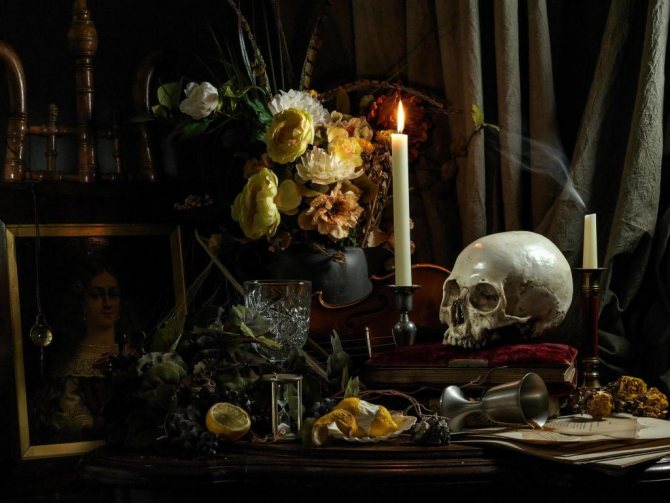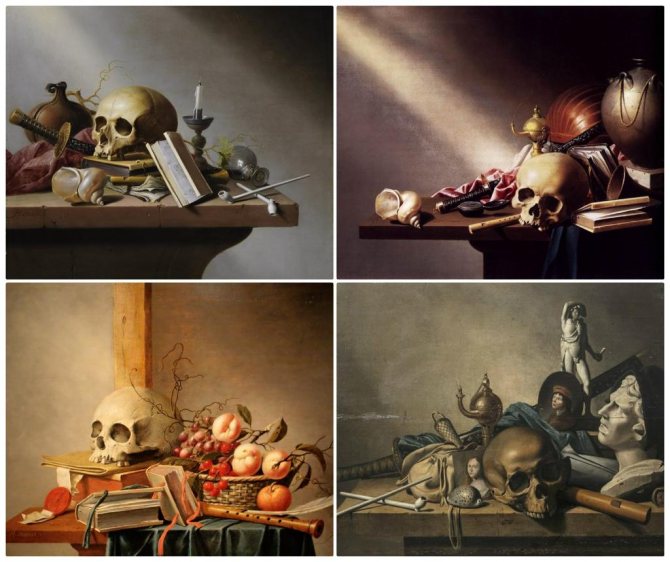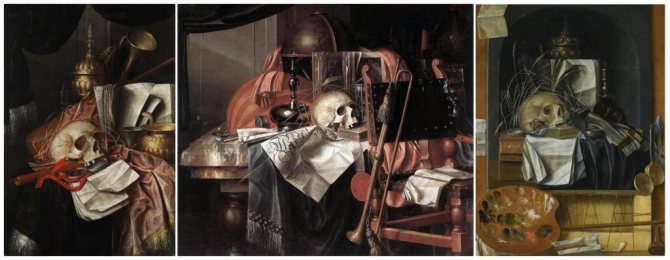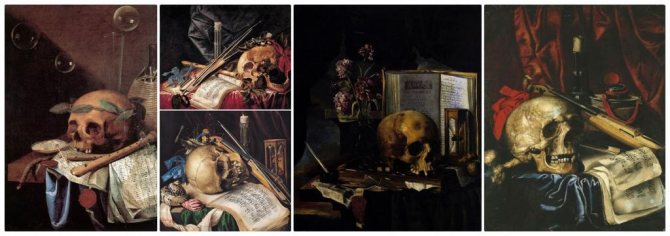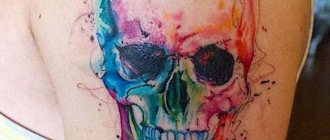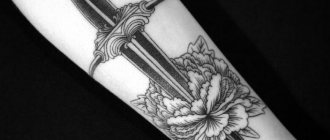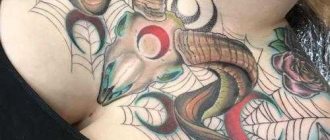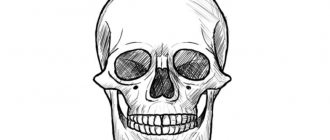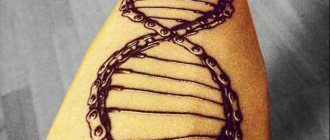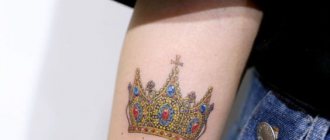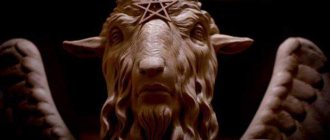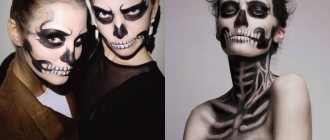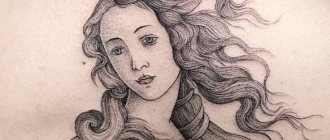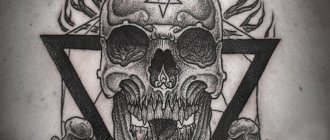The Mexican skull is a very common symbol today, which can be seen in many different spheres. It inspires fashion designers of clothing, accessories and home products, makeup artists and makeup artists, tattoo artists and decorators, artists, sculptors and designers of all stripes.
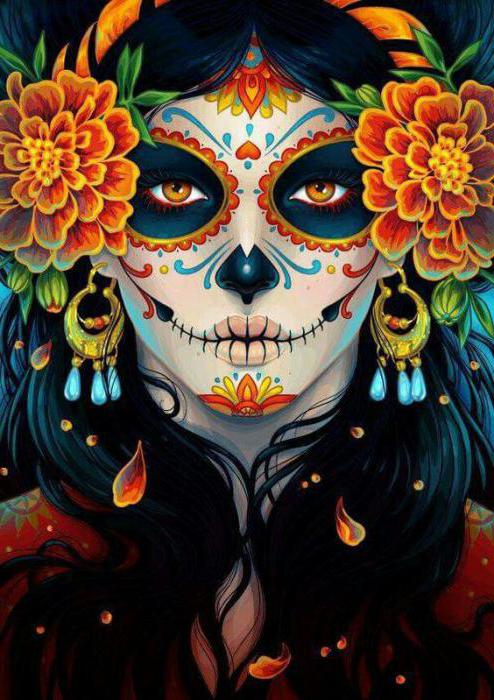
It may seem that painted with multicolored scrolls skull is a threatening meaning or negative energy. But it is necessary to know about this symbol more, as the relationship to it changes on the opposite. Our article will answer the questions of those who are interested in an unusual skull. And a small selection of colorful illustrations will only confirm that this image is not terrible at all.
The history of the symbol
There are many names by which this image is called. The most common are calavera, Mexican or sugar skull.
The history of the skull is connected with Mexico. There, it represents the Day of the Dead, an ancient holiday that was born from the fusion of ancient local culture and traditions of the Spanish conquistadors.
The missionaries brought a new religion and new customs to the mainland. One of them was All Saints' Day. Celebrants were supposed to donate money to the church, which was supposed to help deceased relatives in the afterlife.
But pagan traditions looked at death differently. The local population did not consider someone's passing a grief, and no one even knew about the suffering of souls in purgatory. The deceased in Mexico were commemorated during feasts whose names can hardly be pronounced on the first try: Mikailuitontli and Socotuetztli. None of these days, however, were mournful. On the contrary, the population rejoiced.
We should not have expected that the hardened pagans would instantly learn to be sad at the behest of Old Europeans. This did not happen. The festivities were as cheerful as they ever were. And the natives did not bring gold to the local churches, but gifts: lush fruit, delicate flowers, ripe grain. And the gifts were not addressed to the church, but directly to the departed relatives.
A mixture of customs resulted in a single holiday called Dia de los Muertos. One of the main attributes of the event was an unusual character - Katrina Calavera. She was a skeleton, but not a simple one, and adorned with everything that was possible, and dressed in a magnificent dress. What about it? A holiday, after all!
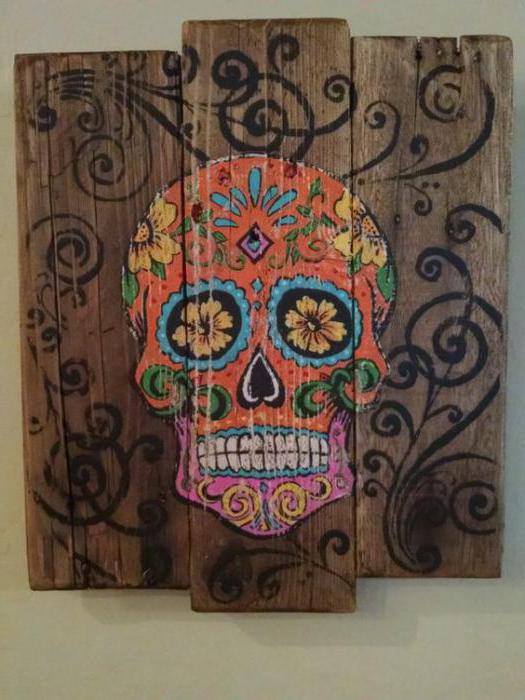

It was in honor of this lady that the Mexicans began to prepare a treat - sugar skulls decorated with multicolored icing. Later the same Mexican skull began to be used for other paraphernalia: garlands, street lamps, outfits, masks and much more. Over the years, the variety of uses only increased, because this image has become a kind of symbol of the country. But the calavera skull has become so popular that it can be found almost everywhere.
Jacob de Gein the Second.
The first Dutch still life with a skull, a reproduction of which can be seen above, was also the first still life for Holland as a whole. Its author was the painter Jacob de Gein the Second, he painted this Still Life Vanitas in 1603. This painting is extraordinary in its power of representation and color depth, and that is how almost all the still lifes of the eminent Dutch masters, including Rubens and Rembrandt, would look. Here the skull is still traditionally placed in the center of the composition and in some recess.
The left vase shows a tulip, a classic Dutch symbol of waste and irresponsibility, while the right vase is occupied by only one wilted stem. It is an allusion to the fact that the rich and the poor, the young and the old, are equal before death. The coins of different denominations scattered in front of the skull also hint at waste. Above the skull in the aperture is a huge glass ball in which the room is reflected - like mirrors, in vanitas such balls signify a false image of reality into which the human body transforms after death. Curiously, de Geyn inscribed decorative figures of a laughing Democritus and a weeping Heraclitus in the arch, characteristic of both the Renaissance and Baroque periods. The canvas is housed in the Metropolitan Museum of Art in New York.
The main photo of the article also shows a painting by this artist called Still Life Vanitas, created in 1621. This is already a typical Baroque still life, filled with many symbolic objects, including a huge number of books symbolizing learning, a laurel wreath, armor and mantle hinting at strength and power, as well as musical instruments and busts - all these things that cannot be taken with them to the grave, and so again the skull is in the center. The artist wanted to say that only the soul has value, and everything else is vanity and temporary, for even one's own skeleton is not left to a person after death.
Skull Mexican Makeup and Makeup
Today, there are fans of colorful skulls all over the world. This image inspires makeup artists and makeup artists. Nowadays, "Mexican Skull" makeup for Halloween, carnival or costume party is quite common.
To cope with the task is not difficult even for someone who has no special education. It is enough to know the basic skills of applying cosmetics. If you dare to do such an experiment, our little cheat sheet will help.
- The base tone of your face is usually light. It can even be white or silver, but if such a radical makeover is not to your liking, use a regular foundation that is a few shades lighter than your "native.
- Highlight the area around the eyes. It is usually made in black, purple or dark green. You can also use other shades, including gold and silver.
- The lips are usually painted the color of the main tone of the face. And from the corners of the mouth to the cheeks, thin lines are drawn with perpendicular dashes to give a resemblance to the skull.
- The tip of the nose should also be highlighted in dark.
- It is possible and even necessary to use rhinestones and other decorative elements (they can be fixed with glue for false eyelashes).
- With the help of thin makeup pencils on the cheeks, chin and forehead you can draw flowers.
Vanitas allegorical still life
But still, what is the name of the still life with the skull? The answer is contained in the subtitle - vanitas, which literally translates from Latin as "vanity" or "vanity. Such paintings are not just a type of still life, but also one of the earliest, along with pictorial depictions of game and other prey from the hunt. But why exactly did they get such a name? The fact is that the word "vanitas" is repeated several times in a saying taken from the Latin translation of the Bible:
Vanity of vanities, said Ecclesiastes, vanity of vanities - all is vanity!
"Vanitas vanitatum" is exactly what "vanity of vanities" means. The first vanitas were not independent paintings at all - monochrome still lifes with a skull and candlestick were traditionally painted on the back of Renaissance portraits. This symbolized the frailty of existence, alluding to the mortality of the person depicted, the flip side of life. Although vanitas flourished significantly as an independent sub-genre during the Baroque period, the first such still lifes were also found in the 16th century, continued to appear in the 19th and 20th centuries, and are also sometimes used today. The allegorical meaning with which skull still lifes are filled will never lose relevance.
De los Muertos style mask.
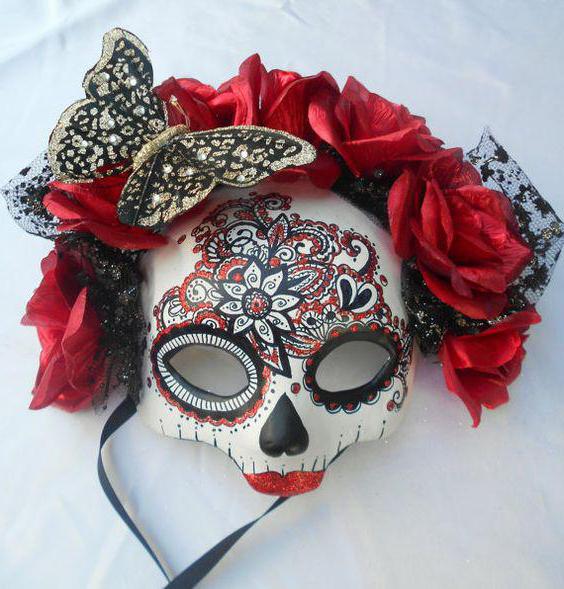

What carnival can do without this accessory? There are a huge number of ready-made masks on sale, but you can also make this stylish thing with your own hands. For this you will need a white solid-colored mask, which can be found in any department of holiday paraphernalia. The Mexican Skull (Female) mask can be painted with regular acrylic paints in the same way as the makeup: dark areas around the eyes and on the tip of the nose, painted with flowers, rhinestone decorations. Want more decorativeness? Think back to what the Indians used to decorate Katrina Calaveras and use the same materials. Roses from foamirin or plastic, lace, beads and bows will fit harmoniously into the overall style.
The main features of the image
The image of the Holy Death is something between a skeleton and a young blooming man, so the following details are used when creating it:
- white skull face with obligatory decoration with patterns, it is desirable to make up not only the face, but also other areas of the body not hidden by clothes, or to make a smooth transition from the made up areas to free;
- Girls' clothes should be bright, dresses with floral prints will do. It is necessary to use jewelry, preferably in a vintage style, as well as other details of the "femme fatale" image - stockings, high-heeled shoes. A specific detail of the image is a lace shawl. Men should choose an evening suit with a bright tie;
- Flowers - natural or artificial, it does not matter. Girls can use wreaths or headbands with large bright flowers. Men decorate the crown of a hat and the lapels of a tuxedo (jacket) with flowers.
Skulls on the catwalk and in everyday fashion
Those who follow fashion, probably by now remember one of the most famous and famous fans of skulls - Alexander McQueen. He used this element to create handbags, shoes, clothes, jewelry, accessories. His models, in which the luxury and the gloomy gothic intertwined, more than once conquered the fashion world by their peculiar charm.
The skull in the Mexican style can often be seen on casual wear as well. And it is equally popular among fans of dressing up of both sexes.
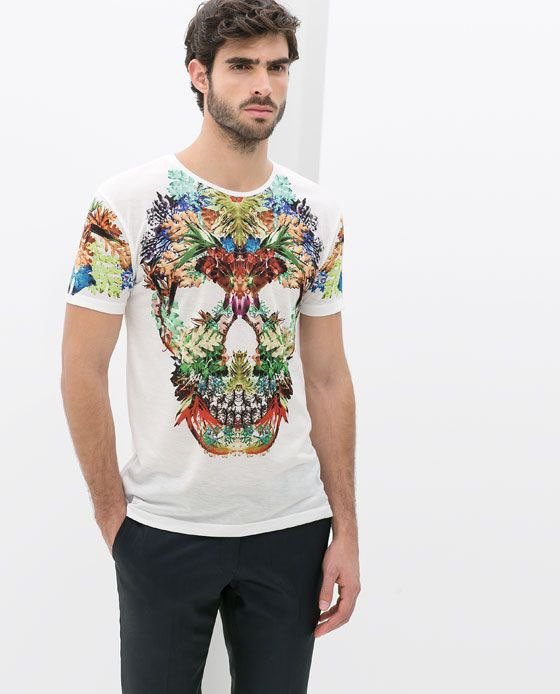

In the illustration above is a model from the recent ZARA collection. The sugar skulls can also be found in the catalogs of Pull&Bear, a fashionable youth brand.
Bartholomew Brain Senior
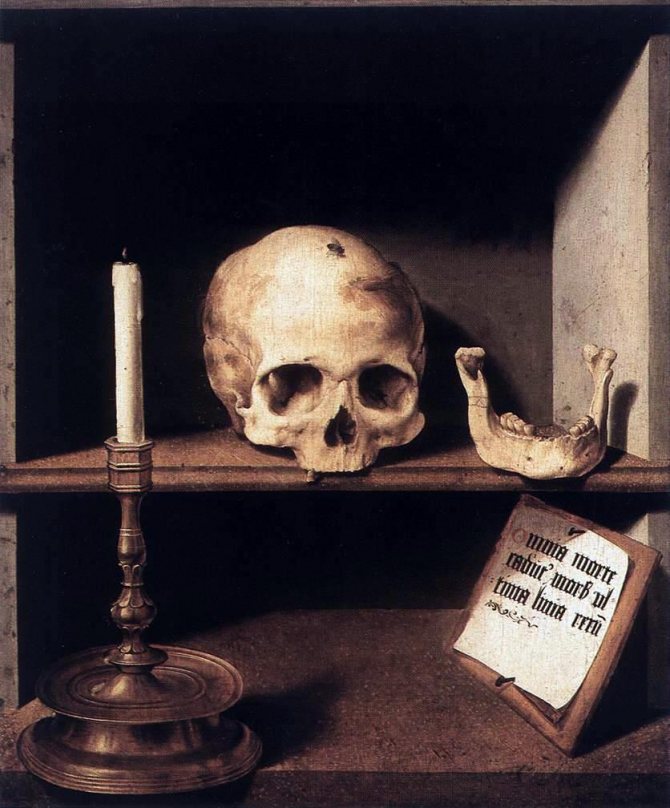

The reproduction above shows a 1524 still life with a skull and candlestick titled "Vanity of Vanities," painted by the German artist Bartholomew (Bartholomeus) Brein the Elder. The key objects characteristic of vanitas are depicted in this minimalist Renaissance painting. As in all subsequent paintings, the center of the image is the skull, but in this case the separately lying lower jaw is curious. The extinguished candle symbolizes a departed soul. Also very characteristic of early vanitas is a piece of paper with a Latin moral - in this case it is the phrase "Everything is destroyed by death, death is the final frontier of all things.
It should be noted that this painting is one of the first of its kind, so that Bartholomeus Brein can safely be called one of the progenitors of vanitas painting. At present, the painting is in the Kreller-Muller Museum in the Netherlands.
Home Accessories
You probably noticed the collection of funny sofa cushions (photo below), which are decorated with a Mexican skull. This home accessory, as well as many others in the same spirit, created by Chinese designers. In the Middle Kingdom, too, calaveras has found many admirers. Today on sale you can easily find curtains, linens, dishes and other household products. And one of the most famous manufacturers of toys, the American , even released a doll Skelita, which makeup is made in the best traditions of the Day of the Dead.
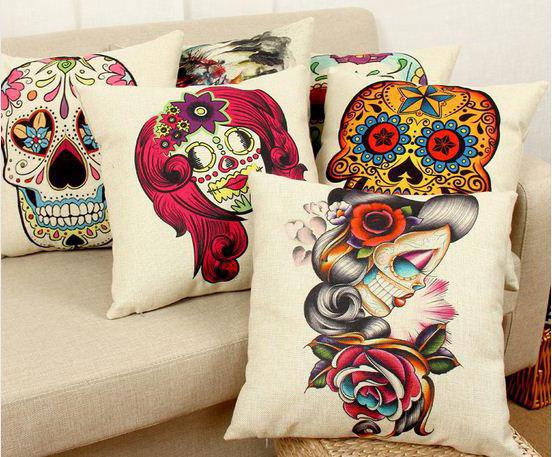

Peter Claes.
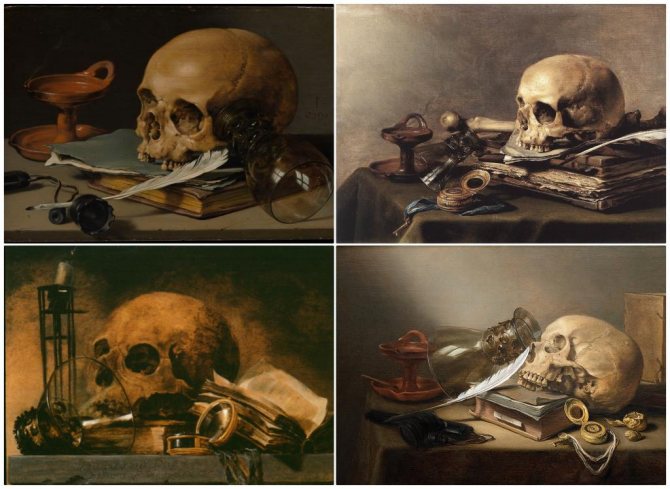

Peter Klass, another Dutch painter, was also a big fan of still lifes with skulls. He had more than a hundred different Vanitas paintings to his credit, sometimes redrawing the same composition several times, changing any minor object or angle of light in it. Above you can see reproductions of the following paintings:
- "Still Life with Skull and Feather," 1628.
- "Vanitas," 1630.
- "Vanitas Still Life," 1630.
- "Vanitas still life with book, skull, oil lamp, shot glass and pen," 1630.
Peter Claes' skull still lifes possess a number of ever-present objects. An oil lamp or candle, a quill, a pocket watch, nuts, and a tipped glass-usually with a spiked stem-almost always complete the composition. As we already know, candles and lamps symbolize a faded life, the pen, like books, symbolizes learning. The presence of a clock hints at the fleetingness of time or a stopped life, crushed nuts speak of a broken body shell, an overturned glass - the abuse of drunkenness.
Most of this artist's vanitas still lifes are in the Metropolitan Museum of Art in New York.
Adrian van Utrecht
Above you can see a reproduction of Adrian van Utrecht's painting Vanity of Vanities, which the Belgian artist painted around 1640. Another title of the painting is Still Life with Bouquet and Skull. All of the symbols represented in this vanitas are related in one way or another to vanity and waste, predominantly female. A bouquet of tulips and roses and a huge shell speak of frivolity and lust, a huge amount of jewelry, coins and two kinds of champagne glasses speak of waste, a smoking pipe symbolizes voluptuousness and love of fleeting pleasures. The Vanity of Vanities is now in a private collection.
